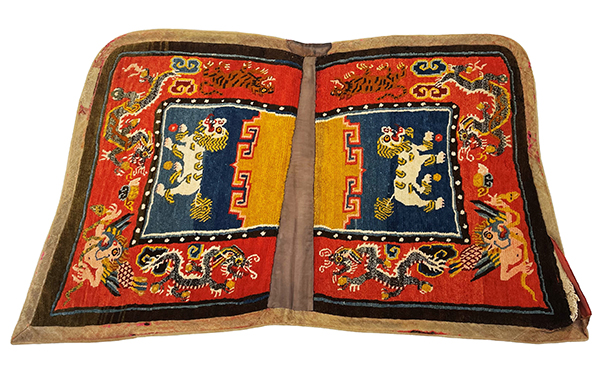Tibetan Saddle Rug

Historically, saddle rugs like this one were central to the tradition of horseback riding in Tibet. This type of saddle rug was used for cushioning between the horse’s back and the saddle. A second smaller rug would have been placed on top of the saddle for the comfort of the rider. Because Tibetan saddles were often made of wood, these rugs made riding more comfortable for both the horse and the rider. Many under-saddle rugs are made of two woven pieces joined together, as this one is. The shape of this rug with a pair of pointed corners is referred to as a butterfly design.
Known for their rich colors, unique decorations, and exquisite craftsmanship, Tibetan rugs can be classified as either religious or utilitarian. Utilitarian rugs such as saddle rugs can also feature imagery that expresses people’s beliefs. More detailed and intricate patterns indicate the owner’s higher socioeconomic status.
The main decorations found on this saddle rug are dangerous creatures: dragons, tigers, lions, and bird-like Garudas fighting with snake-like Nagas. Dragon imagery is common on saddle rugs because it represents wealth. Merchants may choose this kind of rug to win the dragon’s favor, hoping for good fortune in their business.
The humanoid figures at the edge of the saddle rug are the Garuda in anthropomorphic form. Garuda is the “Lord of Birds” in Hindu Buddhist tradition, but it sometimes has a more sinister characterization in Tibetan Buddhism. The Naga are a type of intelligent and evil serpents; here they are being devoured by the Garudas. Thus, the appearance of the Garuda often represents protection.
The two snow lions in the center of the rug are celestial animals that indicate power and fearlessness. Tigers are considered to have the extraordinary power to cast out demons and control evil. The combination of the dragons, Garudas, snow lions and tigers on the saddle conveys hope for being safe during transportation and having good fortune in business.
This saddle rug is from the Nicholas Salgo Collection. See how it compares to other Tibetan saddle rugs in the Museum’s collection through the Saddle Rugs and Tibetan Culture virtual exhibit.
Research and writing for this post were provided by Michelle Ye (’25).
